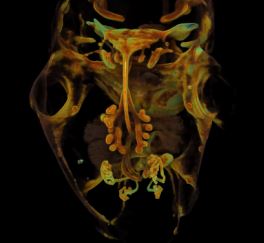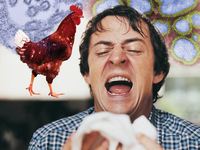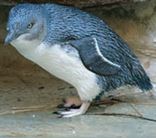 The next time you step on a big, spiky pinecone, blame a dinosaur. A new study suggests that these seed carriers used to be soft and thin but that they had to toughen up when dinos with long necks started nibbling on them.
The next time you step on a big, spiky pinecone, blame a dinosaur. A new study suggests that these seed carriers used to be soft and thin but that they had to toughen up when dinos with long necks started nibbling on them.
Conifers, such as today’s cypresses, Douglas firs, and giant redwoods, produce two types of cones: slender male cones that release pollen and bulky female cones that house the seeds. Ancient conifers also produced two cones, but palaeobotanist Andrew Leslie of Yale University noticed that they were both slim and unassuming, like today’s male cones.
Eager to find out what made the female cones bulk up, Leslie scoured the world’s herbariums—calipers in hand—in search of well-preserved fossil conifers. He compared the 70 or so specimens he found with more than 200 living species. Leslie’s early observation stood up: Female cones have gotten fatter. This widening was not a result of larger seeds but instead a broadening of the scales with which the cone arms itself against grazers, he reports online today in the Proceedings of the Royal Society B.
Leslie found the first cases of wider seed cones in the Jurassic period, a time when very large vertebrate herbivores, such as the long-necked sauropods Diplodocus and Barapasaurus, roamed Earth. These dinosaurs would have been able to graze much higher than earlier species, putting female cones at risk.
Scientists are still debating whether sauropods lifted their necks to feed from the tops of trees, as giraffes do. But even without reaching up, they could graze up to a height of 5 meters. “This still represents a notable increase in browsing height compared to previous vertebrate herbivores, which were mostly browsing around 1 meter or less,” Leslie says.
“It is quite a striking pattern now that someone has pointed it out,” says plant evolutionary biologist Peter Crane of Yale, who was not involved in the study. Still, one shouldn’t rush to blame sauropods, he says. “I don’t think we should forget early birds and mammals.”
Leslie agrees: “The fossil record is pretty useless for showing what was living up in the trees.” This makes it difficult to establish whether conifers were arming themselves against taller dinosaurs or against early mammals and birds that were also beginning to appear in the late Jurassic and early Cretaceous periods. Even insects could have played a role. “We also see an increase in the types of insect mouth parts,” Leslie says, so insects could have broadened their diets to include conifer cones.
:: Read more here ::








